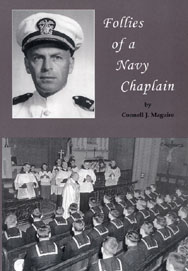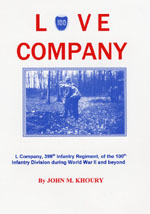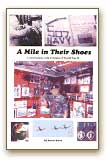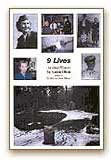July 3, 1944, was the 712th Tank Battalion's first day in combat. Three hundred and ten more days would follow, most of them actively engaged with the enemy.
©2014, Aaron Elson
At a little after noon on July 3, 1944, the five medium tanks in the first platoon of A Company of the 712th Tank Battalion were heading toward their first combat assignment, outside the village of Pretot. The fourth tank was commanded by Jule Braatz, a recently married 26-year-old sergeant from Wausau, Wisconsin. Braatz, like a substantial number of the 765 men in the battalion, had volunteered for the draft in 1941, figuring he would put in his year in the service and be done with it. Then Pearl Harbor was attacked. Now, three years later, as he wiped the sweat from his brow and focused on the back deck of the No. 3 tank about fifty yards ahead of him, Braatz was about to begin acquiring a reputation few sergeants cherish: He was about to lose his first of several lieutenants.
Braatz’s tank hadn’t fired a shot when the radio crackled to life. Corporal John "Porky" Pelletierre, the gunner in the lead tank, was shouting through it that Lieutenant Tarr was hit.
George C. Tarr of West Newton, Pennsylvania, had been a likeable officer. When he gave a lecture on arms or on map reading, some of his colleagues recall, he seemed befuddled by the material. He became a father shortly before the battalion went overseas, and was fidgety on the train from Fort Jackson, South Carolina, to the port of embarcation near Boston. His nervousness was infectious, so his company commander, Cliff Merrill, tried to keep him busy. Merrill told Tarr to take a head count, and Tarr remarked that he had done that just an hour before.
"Yes," Merrill says he told Tarr, "but we’re going into combat, and some of these boys might just get the damn fool notion to jump off the train." Tarr took the head count and reported that everybody was present.
On July 3rd, Tarr was looking for the battalion of paratroopers from the 82nd Airborne Division to which his tanks were assigned when he passed through the first platoon of Company C of the 712th, under the command of Lieutenant Jim Flowers. Flowers, whose tanks were set off the road in a holding position, recalls telling Tarr that he was on the wrong road. He says Tarr thanked him, and continued down the road, intending to look for a way to get over to where he should have been.
A little further on, Flowers says, Tarr stopped his tank again, climbed down, and spoke with an infantry officer. He began to climb back up the side of the tank when he apparently thought of something else, jumped back down, and again spoke with the officer. As he climbed back up the side of his tank a mortar round, which would have done little damage if he were inside, struck the tank and knocked Tarr off. A second round exploded near him on the ground, killing him if the first round hadn’t done so already.
Tarr’s crew — the driver, Percy Bowers; the assistant driver, Russell Levengood of Pottstown, Pennsylvania; Pellittiere, the gunner; and the loader, whose name Braatz doesn’t recall — was shaken up. Braatz told them he would be taking Tarr’s place in the turret, and that they still had a job to do.
Before the platoon reached their assignment, the No. 3 tank bogged down in a muddy stretch of road, and the fourth and fifth tanks were unable to negotiate their way around it, so when he arrived at his destination, Braatz was able to deliver only two of the five tanks the infantry had been promised.
The captain to whom he reported pointed to a farmhouse down the road, and said his men were drawing fire from it. He assured Braatz that the road was cleared of mines, and placed some of his men on the decks of the tanks for the assault.
"Fire when you're ready!" Braatz shouted to Pellittiere, who sat below him in the turret of Tarr’s tank. Then he called to Bowers through the intercom: "Proceed down the road!"
A few moments later the tank shuddered, and Braatz heard a loud noise. He thought at first that it was the backblast from the 75-millimeter cannon, and couldn't understand why Pellittiere and the loader were suddenly trying to push him out of the turret.
The tank had run over a mine.
Braatz and the other crew members scrambled to a ditch by the side of the road. When he looked around, Braatz noticed that one crew member was missing.
"Where's Levengood?"
"He came out the escape hatch," Bowers said.
But Russell Levengood had not gone through the escape hatch on the floor of the tank. The explosion had ripped the hatch cover from its fastenings and blasted it upward with such force that it turned into a deadly projectile. Captain Merrill, the A Company commander, says the hatch cover separated Levengood’s ribs from his back as it shot toward the ceiling of the driver’s compartment.
The second tank, meanwhile, had turned around and headed back down the road. Braatz was still pale and shaken, and the infantry captain was yelling because he didn't have any tanks.
"What the hell am I supposed to do?!" Braatz yelled back. Indeed, nothing in his three years of training, first in the horse cavalry and then in the armored force, had prepared him for a situation such as this.
Braatz told Pellittiere and Bowers and the loader to try and find their way back to the rear on foot, and he set off to find the No. 2 tank. He caught up to it on the side of the road, where it was sitting with the platoon’s fifth tank, commanded by Joe Gaffron, which had worked its way around the bogged-down tank.
Braatz berated the commander of the No. 2 tank, ordered him to climb down into the turret compartment, and took command of the tank himself. The two tanks then returned to the paratroopers, who were getting ready to attack a hedgerow at the far end of a field.
As his tank approached the middle of the field, Braatz looked down and saw pockmarks opening in the grass around him. He wondered why the shells weren’t exploding, and suddenly realized that the pockmarks were being made by armor-piercing shells. It was about two hundred yards back to the beginning of the field, but he shouted into the intercom for his driver to turn the tank around, and hastily motioned for Gaffron’s tank to do the same. The two tanks sped back to the safety of the nearest hedgerow.
Orval Williams was a child in Quinton, Okla., when his brother Tom, the oldest of the family's nine children, went off to fight in World War I. Tom told the family he was going into town, and Orval asked him to bring him back some chewing gum, which the young boy called "chum-chum." Tom returned two years later, without the chewing gum.
Orval was drafted on Nov. 16, 1943. He was inducted at Fort Sill, and a few days later was on a train to Fort Benning.
Williams was rail-thin and redheaded and had been named after an Indian, Orval Billie. He grew up hunting squirrels and rabbits and deer, and considered himself a crack shot. He wanted to be a gunner, but during a loading exercise he says he threw five shells into the breach before the first one landed, and there was no way his tank commander, Sergeant Dan Diel, was going to part with a loader like that. Besides, his tank already had a gunner, Corporal George Vernetti. The driver was John Charles Mitchell, of Argos, Indiana. Mitchell was engaged to a girl in England, and had written to his sister and asked her to send his fiancee a dress. He had entered the service with three friends from high school. One of them, Wayne Hissong, also was in the 712th. The assistant driver was Zygmund Kaminski of Pittsburgh.
As Williams recalls it, the tank came around a bend in the road and he heard an explosion.
Diel, however, says the tank was stationary, and that it was the German tank that came around a corner.
Either way, Williams recalls looking through the periscope and seeing the barrel of a German tank pointing right at him, perhaps fifty yards away.
Diel says there was a high explosive shell in the breach, and that he called for an armor-piercing shell. Looking back, he says that if he had had Vernetti clear the chamber by firing the high-explosive shell it wouldn’t have damaged the German tank but it might have momentarily thrown off the aim of its gunner.
The next shot from the German tank knocked Williams off his seat, and mangled his left hand. He looked down at where the driver was sitting. The top half of Mitchell’s head was gone.
Vernetti, Diel and Kaminski all got out of the tank without serious injury, but once on the ground Vernetti was wounded in the foot and Diel in the leg by machine gun fire.
Williams managed to pull himself out of the tank with his one good arm and dropped to the ground before a second round hit the tank and the ammunition inside began to explode. The tank would be hit by three more shots from the German tank.
It is difficult to say who the first casualty was in the 712th Tank Battalion, because individual companies were attached to different infantry battalions, and the three platoons of each line company were with different infantry companies. Lieutenant George Tarr was the first member of A Company to be killed. T-4 John Charles Mitchell was the first to be killed in B Company. Sergeant Phillip Schromm of San Mateo, California, who had been an A Company driver but transferred to Headquarters Company, was killed by a mortar shell while leading a reconaissance patrol.
Some veterans of the 712th Tank Battalion say that William Schmidt of C Company was the first man in the battalion to be killed.
Corporal Stanley Klapkowski of McKees Rocks, Pennsylvania, was the gunner in Sergeant Schmidt’s tank. At 24, Klapkowski was one of only a handful of members of the battalion who had already seen combat. Klapkowski had tried to volunteer for the Army in 1941 but was rejected because he had flat feet, so he went to Canada and joined the Polish Navy. He became a gunner aboard a destroyer escort named the Lightning. One day, he says, the Lightning sank a German submarine, and as the survivors swam to the Polish ship, they were pulled aboard, their throats were cut, and they were thrown back into the water.
Klapkowski went AWOL after the Polish fleet was bombed and strafed in an English harbor. He returned to the United States, and in 1943 was drafted, flat feet and all, and assigned to the 10th Armored Division at Fort Benning.
The second platoon of C Company had not yet been committed to combat, Klapkowski recalls, when Schmidt thought he saw some movement in some trees and decided to take his tank and check it out. Schmidt was firing his .50-caliber machine gun into the trees when the sniper he was shooting at picked him off instead. He fell on top of Klapkowski, who thought Schmidt was kidding until he saw the blood coming out of Schmidt’s forehead.
Klapkowski says he fired several high-explosive shells, and then told his loader, Pfc. Charles Vietmeyer, to get out of the tank and direct the driver back to the American lines. He says Vietmeyer got out of the tank and started running, and that he considered shooting Vietmeyer but he thought that only an officer could shoot an enlisted man without being court-martialed. He then dismounted and directed the driver, Cardis Sawyer of Cherokee, Texas, back to the American lines.
When he got there, Klapkowski says, an infantry colonel told him that his tank had singlehandedly held off a counterattack, and asked how they had known to go where they went. Klapkowski told the colonel that Schmidt had seen some activity and decided to check it out, although he still believes that if the tank had been knocked out the Army would have made the crew pay for it, because they had were not on an official mission.
Schmidt was awarded a Silver Star, posthumously, and Klapkowski got a Bronze Star.
Art Hary, an ammunition carrier, was wounded by shrapnel as he walked in formation along a road. Hary had been a tank driver until the Tennessee maneuvers, where he says he drove the way his father taught him: hugging the right-hand side of the road. In a car on an open road that may be fine, but in 33 tons of steel on a narrow mountain pass, it can scare the hell out of the tank commander. After several nervewracking moments during which the right track came perilously close to tipping the entire tank over a steep embankment, Sergeant Johnny Young shouted: "Hary, stop the tank! Androkovich, drive the tank!"
Thus Michael Androkovich of Needham, Mass., became a tank driver and Hary an ammunition carrier.
(When Hary recovered from the wound he received in Normandy, he was reassigned to the 357th Regiment of the 90th Infantry Division during the Battle of the Bulge. He was wounded again within an hour after reporting to the front.)
The three assault guns in the Headquarters Company platoon were essentially medium tanks with a larger gun mounted on the turret than the line-company tanks had.
The platoon was assigned to Company I of the 359th Regiment of the 90th Infantry Division. In the afternoon, under cover of a smokescreen that was to be laid down by the Navy, the assault guns were to take part in an attack on the village of Pont Auny.
Although one of the battleships in the English Channel did fire two smoke shells into the area, the smoke quickly dissipated, and the attack was made in broad daylight.
Androkovich drove the lead assault gun between two hedgerows and into an apple orchard. Corporal Eddie Ritz was the gunner, and Young was the tank commander. Lieutenant Sam Adair, the platoon leader, was along for the ride.
If the 712th was entering combat for the first time, the Germans were already well-versed in the art of tank warfare. A camouflaged Mark IV tank in a corner of the orchard allowed the lead assault gun to pass, and then fired on the second. This was a tactic designed to cut off the lead tank and block any others following the second one.
The armor-piercing shell went in through the front of the second assault gun and out the back. A second shot sent flames shooting out the top.
In the lead assault gun, Young rotated the turret and Ritz fired the high-explosive shell that was in the chamber of the gun. It flew harmlessly over the German tank.
The Mark IV by now had turned so that its gun was pointing at Young's tank and it fired, striking the tank low, in the track. Ritz lowered the 105-millimeter gun as far as he could and fired another round. This one struck the German tank just below the gun with a shower of sparks.
The German tank didn't catch fire, but must have been damaged, because the crew bailed out through an escape hatch in the rear and disappeared into the brush.
Bob Atnip of Clementsville, Kentucky, was the loader in the third assault gun. When the second assault gun was hit, he saw the tank commander, Sergeant M.P. Shelton, pulling the gunner, Corporal Herman Hall, by the shoulders up and out through the turret hatch.
Then the second shell hit and the tank burst into flames. The assistant driver, Olen Rowell of Decatur, Mississippi, got out through the belly hatch and made it to a ditch. The driver, Philip Morgan of Arden, North Carolina, though badly burned, climbed out through the driver's hatch and made his way to a farmhouse that had just been abandoned by the Germans. The retreat was so fresh, in fact, that Atnip had to confirm that Morgan was an American when some GIs brought him out, in shock and with his eyes swollen shut. Because his tanker's helmet was different from the kind the infantrymen wore, they thought he was a German.
The No. 2 assault gun's loader, Pfc. Richard Howell, who the day before had mailed three postdated letters to his wife, Lillian, in Arcadia, Louisiana, was still inside the burning tank.
Young's tank, meanwhile, was unable to move because of its broken track. Lieutenant Adair didn't want to risk having it fall into enemy hands with a full load of ammunition, so he asked Ritz to stay with him and sent the rest of the crew back to the rear. He then traversed the gun in the direction of the German lines, and with the lieutenant loading and the gunner firing, they used up most of the tank's remaining 105-millimeter ammunition. When they were down to their last few shells, Adair missed a beat in the rhythmical loading and firing, and the recoil smashed his shoulder.
Before going back to the rear, Androkovich and Ritz went over to check out the German tank. The body of the gunner was still inside.
"Look at this!" Ritz said as he and Androkovich poked around the tank. Ritz was over by the gun. A round was in the chamber, and the breach was closed. They both knew that a split second more, and their tank would have met the same fate as the No. 2 assault gun.
Atnip's assault gun spent the night in the orchard with the infantry to guard against a counterattack. The following morning, Atnip went into the burned-out assault gun to look for any sign of Howell. Nobody had seen him get out of the tank, and with more than sixty rounds of ammunition exploding and all the fuel and oil burning there was nothing more than twisted metal inside the hull. On the bottom of the tank, Atnip found some brass buttons from a set of fatigues.
Sergeants Ed "Smoky" Stuever and Adam Kochen of Service Company arrived with a tank retrieval unit, but the retriever turned out to be unnecessary. It only took their crew less than fifteen minutes to replace the track blocks on Young's tank. Then they went over to inspect the knocked-out German tank.
When they finished replacing the track blocks on Young's assault gun, Stuever and Kochen climbed into the German tank to take a look around. The dead gunner was still in his seat. His billfold was on the floor, where a GI had probably dropped it after rifling through it.
Stuever picked the billfold up, and looked at a picture that was still inside. The photograph showed the gunner, blond-haired, in his twenties, smiling, with a young frau and two tow-headed children.
Many months later -- after the 712th had broken out of Normandy and raced across France and crossed the Moselle River and then the Saar and had come back across the Saar and gone up into the Battle of the Bulge and crossed the Moselle again and then the Rhine and had broken through the Siegfried Line and was penetrating into the heart of Germany, Stuever led his tank retrieval unit into one of a thousand villages that the 712th would pass through before the end of the war. Sometimes there was a battle for the village and sometimes there wasn't, but either way it was already occupied and the infantry and the line-company tankers had picked out their houses for the night.
When Stuever arrived, he was directed to a house where he and his crew were to be billeted. The German woman who lived in the house was upstairs, and the soldiers were to take the first floor.
A framed photograph on a table caught Stuever's eye. His face turned ashen and his heart began to race. It was a picture he had seen before.
Shaking, he called upstairs to the German woman and asked her to come down. He asked the woman in broken German who that was in the picture. She said it was her husband, and those were her children.
The woman asked him why he wanted to know. He said he was just curious, and excused himself.
The woman returned upstairs. Stuever went outside, and spent the night curled up on the floor of the tank retrieval unit.






